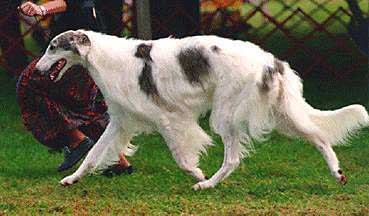|
|
|
How big are Borzoi? It depends on your perspective! The Standard sets the minimum for males at 28" and the minimum height for bitches is 26". Whereas Borzoi below these heights are to be severely penalized, you are unlikely EVER to see one too small.
These minimums are 2" shorter than Scottish Deerhounds and 4" shorter than Irish Wolfhound minimum height, breeds that one seldom encounters at the low end of their standards. That makes the Borzoi, on average, only the third tallest dog in the Hound Group. Size is not type, and extra size for its own sake is not to
be rewarded. There have always been very large dogs, and extra
size is usually gained at the expense of angulation, loss of
symmetry, endurance and agility. Within the very wide, limits
of the standard, size is neither a fault nor a virtue. It is
value neutral, so think very hard Gait
"Hind legs farther apart" refers to general structure and should rightly apply to standing. The dog needs the broad pelvis (remember the gallop?) to allow the hind legs to pass the ribcage without interference. The Borzoi should NOT move wide in the rear. It needs to bring all four legs under the body for support at the trot, and at a fast trot will tend to single track. You don't always see a fast trot in the show ring; if you do, it is probably a short stepping dog moving his legs very fast to cover ground. Don't expect single tracking in the 25 foot cross mat of an indoor ring, but the tendency should be there. A flexible topline will flatten out somewhat as the dog moves at the trot. An inflexible one will not and the dog will bounce. Sometimes puppies will move with more arch in the topline, but will tend to settle down with age if properly made. Very straight rears give a stiff trot, though the animal may be sound coming and going. Many an otherwise nice moving animal will overreach, as Borzoi tend, like so many breeds today, to be more angulated in rear than in the front. We do not need Borzoi to be the Great American Showdog, with tremendous reach and drive in the German Shepherd style flying trot. Balanced, smooth, collected and powerful gait with no wasted vertical motion is the ideal.  |
|
|
|
|
|
|
|
|
|
|
|
|
|
|
|
|
|
|
|
|
|
|
|
|
|
|
|
|
I